
How to make TU/e a more sustainable university
An introduction of the Sustainability Core Team
TU/e has put together a Sustainability Core Team to bring order to the chaos of good intentions to be or become a sustainable university. Students are welcome to contact the Go Green Office to gain or develop ideas. Five study associations have already signed the single-use plastic covenant.
There is so much going on at TU/e in terms of sustainability that you can hardly see the forest for the trees. Just a few examples: student teams building solar vehicles, researchers processing diaper waste into concrete, using Billie Cups in the canteens and collecting coffee grounds separately for recycling. But there is also much left to do: there is no policy in place for sustainable business travel, not every lecture hall has energy-efficient LED lighting yet, and not every student is taught about climate change.
But now, a Sustainability Core Team has been established that is going to draw up an overview of all the different sustainability projects and initiatives that are being undertaken in the areas of education, research, governance and operations.
In 2018, TU/e was named the most sustainable institution in Dutch higher education. In 2022, it placed 7th and Erwin Kerkhof, sustainability advisor at Real Estate, is very pleased with this. “This means we’re back on track after ranking 19th. We were leading the way but we fell behind because we didn’t have an overarching vision. We’re putting a lot of effort into that now, for example by appointing Sustainability Ambassador Anna Wieczorek, and we’re already getting back on our feet.”
Making a university sustainable is not an easy task. Lotte Meijer, a member of the Sustainability Core Team, offers the following definition of sustainability: “Create the best possible life for yourself without limiting the lives of future generations.”
Sustainability Core Team
In late May, the Sustainability Core Team introduced itself to TU/e students and staff. They want to make their work more collaborative by engaging with people outside their own bubble, conversing with all levels involved in education and “making people happy by bringing order to the chaos surrounding sustainability initiatives at TU/e”. In their free time, they insulate their own roof, follow a vegetarian diet or dream of a world in which we only use one means of communication – and it is not email.
Anna Shindler who is in charge of sustainability in research, Iris Moonen (education), Lotte Meijer (governance) and Erwin Kerkhof (operations) introduce themselves below. They describe their ideal workday and to what extent this fantasy differs from reality. They also share useful tips for anyone who wants to reduce their ecological footprint. Kerkhof’s motto: “It’s better for all of us to save 30% than for a small group to save 100%.”
“What changes would students like to see in their education?”
Iris Moonen, PDEng, Sustainability Core Team member in charge of education.
My ideal workday
An ideal day consists of conversations with all levels involved in education. That includes both students, lecturers and organizers. Of course, it’s also imperative to have a meeting with our Sustainability Core Team. These gatherings are energizing and inspiring.
The reality
I certainly try to remain in dialogue with people at all levels involved in education. Students in particular; I always try to involve them in my work. What is their opinion on the current situation and what changes would they like to see? After all, we’re doing it for the students, they are the ones who are directly affected by educational changes.
Our next steps
I’m currently mapping out the present situation. I’d like to know how sustainability is treated in education at the moment. The next step is, of course, to determine what’s lacking and how we can solve this.
My own sustainable living choices
I generally eat vegetarian and make sure to waste as little food as possible. I’ve insulated the roof of my house myself and always grab a sweater or blanket before turning up the heat. I also try to grow vegetables in our garden and always travel by bike or on foot whenever possible.
Tips & Tricks
Look at what you can do to improve your own home; there’s always something that can be done, on any budget. For example, radiator reflectors are not expensive, but they do help to reduce heat losses to the outside.
“It’s better for all of us to save 30% than for a small group to save 100%.”
Erwin Kerkhof, sustainability advisor at Real Estate and Sustainability Core Team member in charge of operations.
My ideal workday
My ideal workday is one in which I can arrange my own schedule. My role is to make TU/e more sustainable in terms of operations. Therefore, I try to link my own ideas and those of others to concrete goals at TU/e. For example, in the morning I talk about vitality and well-being and how we can combine that with more biodiversity on campus. Later that day, I have a meeting to establish a road map in order to determine how we, as TU/e, are going to meet the terms of the climate agreement. I can then present this roadmap to a steering committee so that we know the direction we’re going to take.
In the afternoon, I have a meeting with the GO Green Office to discuss plans on how to engage more students and we come up with initiatives, projects and strategies to make TU/e a more sustainable organization. In this ideal world there would be no email and only one communication channel that automatically deletes unimportant things.
The reality
I have a lot of freedom to determine my own work schedule and to set the direction we’re going to take, in collaboration with the GO Green Office, among others. When you work for a large organization such as TU/e you inevitably have to deal with various forces that interfere with the execution of the vision you have in mind. That can be frustrating at times but it’s also part of my job to find a way through this.
The ultimate goal is to attain a fossil fuel-free campus, where resources are continually reused and there is no waste; where people are healthy and happy and where there’s also room for plants and animals. This ideal vision is described in the Sustainability Vision for Operations.
My own sustainable living choices
I take good care of myself and my environment (exercise, yoga, eating healthy, spending a lot of time outside). I try not to use my car if it’s not necessary and my diet is 95% vegetarian and 70% vegan. I’ve made my garden and house more sustainable (removing paving stones from the garden and replacing them with plants, insulation, solar panels and a heat pump) and I take short and cold showers. I produce as little waste as possible and only rarely buy new clothes. The clothes I do buy are as sustainable as possible or I buy them second-hand on Vinted. I also vote for the right parties during elections, because this is a matter of systemic change and I can’t achieve that on my own.
But I’m certainly not perfect. I haven’t been on a plane in years, but this fall, I’m going to fly to Portugal, I have an old diesel-powered camper van that we use quite frequently and I still occasionally indulge in a bitterbal at parties.
Tips & Tricks
Don’t try to do everything perfectly but try to slowly adjust your habits. If you eat a lot of meat, try to have one meat-free day a week (this way, you reduce your meat consumption by 15%) and you’ll find that it’s easier than you think. Adjust your thermostat and turn it down by one degree. If you get cold, you can turn it up again, but you’ll see that it won’t be necessary to do that very often. Buy a shower timer and hang it in a prominent place. Even if you don’t use it, you might reduce your shower time by one minute (again, 15%) just by looking at it. Use your bicycle for errands you normally run by car (or a shared scooter), and if you usually do them by bike, do them on foot instead.
All beginnings are difficult, so don’t put too much pressure on yourself, make changes one step at a time and think of it as a game.
“More collaboration with not-for-profit organizations”
Anna Shindler, Sustainability Core Team member in charge of research.
My ideal workday
As a researcher, my ideal day involves working in diverse and cross-disciplinary teams. We all have different passions, experiences and strengths so collaborating more, between disciplines and also with communities beyond the university ‘bubble’, can harness our creativity.
The reality
Through my role as a PhD researcher and my work in the Sustainability Core Team, I get to connect to others quite a bit. I’d like to see stronger and open enabling structures at TU/e for researchers who are passionate about sustainability. I’d also like to see more research engaging directly with society through diversifying partnerships, for instance with not-for-profits.
Our next steps
Currently, I am conducting an assessment of TU/e’s research capacity to understand where we stand and what’s missing. For example, we know that 12% of TU/e’s publications over the last 20 years were about sustainability.
I am also interviewing TU/e’s researchers to understand how transformative research for sustainability emerges and is consolidated. We plan to use these assessment results to create a university-wide vision for sustainability.
My own sustainable living choices
Before I became a researcher, I was a vegetarian/vegan chef so I always exchange recipes with friends and family. It encourages us all to reduce our food waste and meat consumption.
Tips & Tricks
Be an active citizen, and utilize your networks and interests. I believe that individual actions are most impactful when connected to wider society. ‘Food’ is a fun way to make a positive impact. You could also join a local action group for an issue you care about, start an initiative with other students or write to the municipality of Eindhoven. We can advise you at the Sustainability Core Team, just ask!
"On municipal land, anyone can start their own vegetable garden"
Dr. Lotte Meijer, Sustainability Core Team member in charge of governance.
My ideal workday
I start the day with a meeting with the Sustainability Core Team. In the afternoon, I work on my overview of the initiatives and I contact the Gate to strengthen our collaborative relationship. But you can’t really squeeze all my work tasks into a single work day... The main focus of my job is to translate research into practice and vice versa. And to make people happy by bringing order to the chaos surrounding sustainability initiatives at TU/e.
The reality
Our team is rather understaffed and we always seem to be putting out fires. I really hope that we will achieve first place in the SustainaBul ranking (hopefully next year already), but for that to happen, we still have a lot of work to do in terms of policy and monitoring.
Our next steps
We will start by mapping out the network surrounding TU/e, how we are doing in relation to others, and how rules and policies can impede or accelerate sustainability initiatives.
My own sustainable living choices
I have my own vegetable garden at home and live in a well-insulated newly built house that’s just about ready to be fitted with a heat pump. Unfortunately, we haven’t completely switched off our gas yet, I would have liked to do so but it proved too complex for the contractors during the construction of our house. We do have solar panels; enough of them to charge our electric car with solar energy. However, I still prefer to travel by bike. Even though I have kids, I hardly need the car. I take them to the TU/e day care center in my bicycle trailer.
Super tip
In 2014, councilor Scheurs signed a covenant in Eindhoven that allows people to start their own vegetable garden on municipal land. That’s why we started a vegetable garden near Woenselse Markt a few years ago, which has grown rather large now. So, if you come across a dead flowerbed, an unused parking lot, or a stretch of unused municipal land: what's stopping you?
Photo: I try to show my children (the future generation) the wonders of this world whenever possible. Our family went to Iceland on vacation, but we chose to travel in our own electric car (on the boat), instead of by plane.
Which association will ban disposable plastics altogether?
In consultation with the thirteen associations participating in the SUMAP project, ‘Sustainability Managers Project’ in full, the GO Green Office set itself an ambitious goal. “We will implement a ban on single-use plastic for association-wide events by the end of the academic year 21/22”, says Meie Kleijburg, Campus Relations Manager for the GO Green Office. “This is the so-called single-use plastic covenant. Under this covenant, associations agree to stop using disposable plastics during their association activities, starting at the end of this academic year. These plastics include disposable plates, cups, drinking straws, Styrofoam, etc. Quadrivium, J.D. van der Waals, study association Intermate, Protagoras (study association of Biomedical Engineering) and Cosmos have already signed.”
Although many associations are on the right track by using festival hard cups, it is quite difficult to completely ban single-use plastics. For example, you would no longer be allowed to hand out currant buns during events, as these are packed in plastic bags in sixes.
“They have to lay down these kinds of long-term choices for associations during official General Assemblies. A further struggle is the use of disposable plastic cups at the end of drinks parties. People who have some leftover drink in their glass, but need to leave the room as soon as possible, have to pour it into a plastic cup so that they can take it outside. For many boards, this last plastic cup proved to be a major deterrent to signing the covenant”, says Kleijburg. Nevertheless, she has no plans to modify the covenant.
Quality over quantity
“We prefer to think along with the boards that haven’t yet signed. To what extent can they reduce their single-use? For example, DEMOS hasn’t signed yet, but they’ve purchased hard cups. This means a reduction of 10,000 plastic cups for their three annual open parties alone, and they also cut back on their use for normal parties. Since making the switch to hard cups in February 2022, they’ve already saved 30,000 cups.” The GGO team decided that the quality of the covenant takes precedence over quantity.
SUMAP, initiated by the GO Green Office, does not only have a knowledge exchange project for boards, but it also has a fun and competitive element. The ‘challenge’ includes a reward system for every sustainable implementation during a board year, explains Kleijburg. “This way, we get an annual overview of which association has made the most progress in terms of sustainability. The current top three are 1. Intermate, 2. Cosmos and 3. Van der Waals.”
Kleijburg knows that five associations have appointed a sustainability committee. “They focus on analyses about the energy consumption of their associations or facilitate a sustainability competition between the existing committees of an association.”
Overall, she feels that the university is getting stronger and stronger in terms of sustainability. “I’m very happy that 21 associations (in addition to the thirteen original associations, seven sports associations have now also become involved – Ed.) and two umbrella organizations are now regularly engaged in sustainability efforts. Unfortunately, there’s still a huge amount of work to be done at the policy level, but I hope that the university realizes that it should be extremely grateful for all the efforts undertaken on this front by so many students and lecturers and that it will welcome these efforts with open arms.”

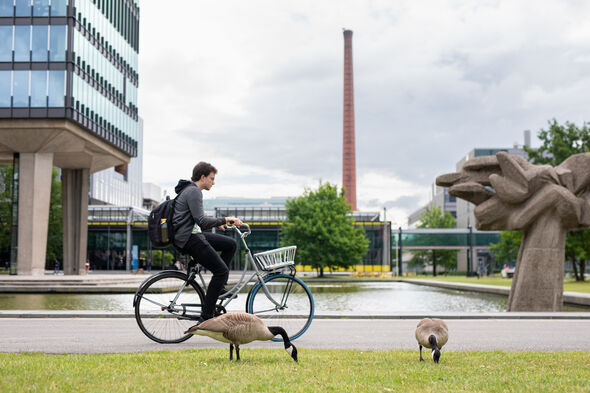
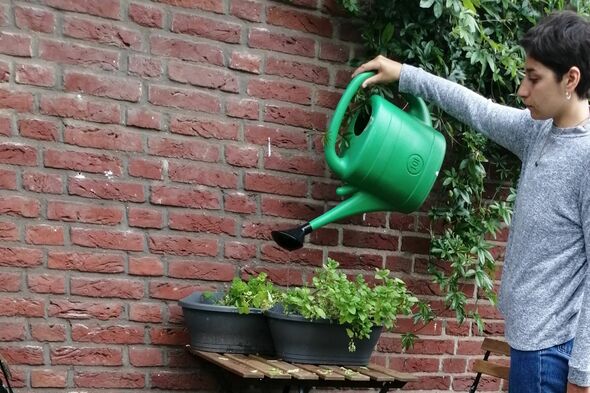
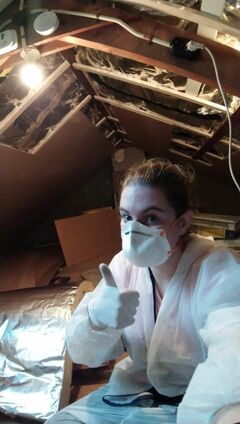
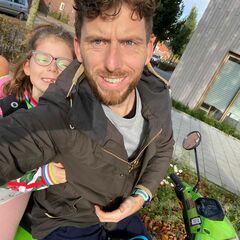
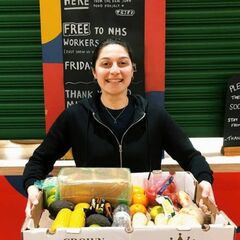
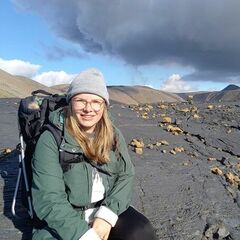
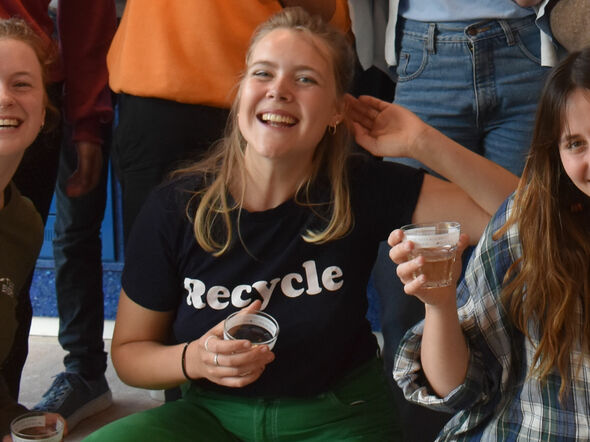
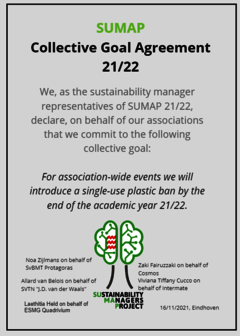
Discussion